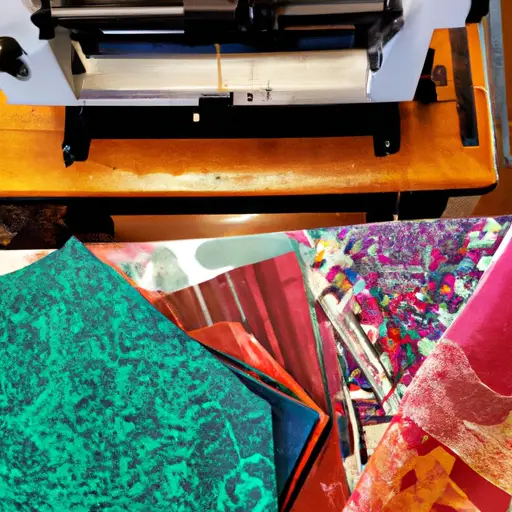Textile printing is a centuries-old art form that has evolved over time, incorporating new techniques and technologies to achieve stunning results. For those who have already dabbled in the world of DIY textile printing, there comes a point when basic techniques no longer satisfy the desire for innovation and creativity. This is where mastering advanced techniques in screen printing and block printing becomes essential.
In this article, we will delve into the intricacies of advanced screen printing techniques, such as mastering photo emulsion. This technique allows artists to transfer highly detailed designs onto screens, resulting in crisp and precise prints. We will explore the step-by-step process of preparing the emulsion, exposing the design, and rinsing the screen to achieve optimal results.
Additionally, we will discover the art of taking block printing to the next level with reduction techniques. These techniques involve carving away sections of the block between each color layer to create intricate and layered designs. We will explore the skill and precision required to execute reduction techniques successfully, as well as the methods for achieving vibrant and seamless color transitions.
For those seeking to push the boundaries of their creativity, we will also delve into the world of multi-block printing. This technique involves using multiple blocks to create complex patterns and designs. We will explore the process of designing and carving multiple blocks, as well as the strategies for aligning and printing with precision.
By mastering these advanced techniques in screen printing and block printing, textile artists can take their craft to new heights. Whether you’re an experienced DIY enthusiast or a professional artist looking to expand your repertoire, this article will equip you with the knowledge and skills necessary to create innovative and stunning textiles.
Exploring Advanced Screen Printing Techniques
Advanced screen printing techniques are a subject of exploration, allowing for the expansion of knowledge and understanding in the realm of DIY textile printing. These techniques go beyond the basics of screen printing and delve into more intricate and complex processes that can elevate the quality and creativity of printed textiles.
One such technique is the use of multiple screens to create layered and textured designs. By carefully aligning different screens and applying different colors or patterns, artists can achieve a sense of depth and dimension in their prints. This technique opens up a whole new world of possibilities for creating visually stunning and unique textile designs.
Another advanced screen printing technique is the use of specialty inks and additives. Artists can experiment with a wide range of inks, including metallic, fluorescent, or glow-in-the-dark options, to add a touch of innovation and excitement to their designs. Additionally, additives such as puff ink or discharge ink can create interesting textures and effects on the fabric.
Puff ink, for example, expands when heat is applied, resulting in a raised and three-dimensional effect. Discharge ink, on the other hand, removes the dye from the fabric, leaving a soft and subtle print. By exploring these advanced techniques and incorporating them into their work, DIY textile printers can push the boundaries of traditional screen printing and create truly exceptional and captivating designs.
Mastering Photo Emulsion in Screen Printing
A comprehensive understanding of the process of utilizing photo emulsion is essential in order to successfully produce intricate and detailed designs in screen printing.
Photo emulsion is a light-sensitive material that is used to create stencils on a screen for printing.
The process involves coating a screen with the emulsion, allowing it to dry, and then exposing it to light with a design or image placed on top.
The areas of the emulsion that are exposed to light harden and become insoluble, while the areas that are not exposed remain soluble.
After exposure, the screen is washed with water, removing the soluble emulsion and leaving behind a stencil that can be used for printing.
Mastering photo emulsion in screen printing requires precision and attention to detail.
It is crucial to ensure that the emulsion is evenly coated on the screen, as any imperfections or inconsistencies can affect the quality of the final print.
Additionally, the exposure time must be carefully controlled to achieve the desired level of detail.
Too much exposure can cause the emulsion to over-harden and make it difficult to wash out, while too little exposure can result in a weak stencil that may break down during the printing process.
Therefore, it is important to experiment with different exposure times and to keep detailed records of successful outcomes for future reference.
A thorough understanding of photo emulsion is vital for achieving intricate and detailed designs in screen printing.
By mastering the coating and exposure process, artists and designers can unlock a world of possibilities for creating innovative and visually stunning prints.
With careful attention to detail and experimentation, the use of photo emulsion can elevate the quality of screen printing and allow for the production of complex and intricate designs.
Taking Block Printing to the Next Level with Reduction Techniques
Utilizing reduction techniques can enhance the artistic possibilities of block printing by creating layered and visually dynamic designs.
Reduction techniques in block printing involve the process of progressively cutting away areas of the block to create multiple layers of color. This technique allows the artist to build up complex and intricate designs, adding depth and dimension to their prints. By strategically planning the order in which colors are printed and carefully cutting away areas of the block between each layer, the artist can achieve a wide range of effects, from subtle shading to bold contrasts.
One of the advantages of reduction techniques in block printing is the ability to create a sense of movement and texture in the final print. By carefully choosing which areas to cut away and which to leave intact, the artist can create variations in color and texture that mimic the brushstrokes of a painting. This adds a unique and handmade quality to the print, making each piece truly one-of-a-kind.
Additionally, reduction techniques allow for a high level of precision and detail. The artist can create intricate designs with fine lines and small details by carefully cutting away small areas of the block. This attention to detail can result in stunning prints that captivate the viewer’s attention and showcase the artist’s skill and creativity.
Overall, the use of reduction techniques in block printing opens up a world of artistic possibilities, allowing artists to push the boundaries of the medium and create visually stunning and innovative prints.
Creating Intricate Patterns with Multi-Block Printing
To achieve intricate patterns in block printing, artists employ the technique of multi-block printing, which involves using multiple blocks to create different elements or layers of a design. This technique allows for greater detail and complexity in the final print, as each block can be carved with a specific pattern or texture.
By carefully aligning and registering each block, artists are able to create a cohesive design that incorporates multiple colors and intricate patterns.
One of the key advantages of multi-block printing is the ability to create depth and dimension in the final print. By using different blocks for different layers of the design, artists can build up layers of texture and color, resulting in a more visually interesting and dynamic print. This technique also allows for the incorporation of fine details and intricate patterns that would be difficult to achieve with a single block.
Artists can experiment with different combinations of blocks to create unique effects and variations in their prints, pushing the boundaries of traditional block printing techniques.
The use of multi-block printing opens up a world of possibilities for artists looking to create innovative and intricate patterns in their block prints. By utilizing multiple blocks, artists can achieve a level of detail and complexity that is not possible with a single block. This technique allows for the creation of depth, dimension, and fine details, resulting in visually stunning prints.
Whether it’s combining different patterns, textures, or colors, multi-block printing offers endless opportunities for artists to push the boundaries of their creativity and produce truly unique and captivating prints.
Conclusion
In conclusion, mastering advanced techniques in screen printing and block printing can greatly enhance one’s DIY textile printing skills. By exploring advanced screen printing techniques, such as photo emulsion, individuals can achieve more intricate designs and patterns on their fabrics. The use of photo emulsion allows for precise detailing and crisp lines, resulting in professional-looking prints.
Furthermore, taking block printing to the next level with reduction techniques opens up a world of possibilities for creating unique and complex designs. By systematically removing portions of the block with each layer of printing, individuals can achieve multi-colored and multi-dimensional prints. This technique requires precision and careful planning, but the end result is a visually stunning textile.
Lastly, multi-block printing allows for the creation of intricate patterns by using multiple blocks, each carved with a different part of the design. By layering these blocks and carefully aligning them, individuals can achieve complex patterns and textures on their fabrics. This technique requires patience and attention to detail, but the final product is a truly one-of-a-kind textile.
In conclusion, mastering advanced techniques in screen printing and block printing can elevate one’s DIY textile printing to a professional level. By utilizing photo emulsion, reduction techniques, and multi-block printing, individuals can create intricate and visually stunning designs on their fabrics. These techniques require precision, patience, and attention to detail, but the end result is well worth the effort. With practice and dedication, anyone can become a master of DIY textile printing.
 printablelabelstemplate
printablelabelstemplate
